#parallel synthesis
Explore tagged Tumblr posts
Text
(Slight TW/CW for injury)

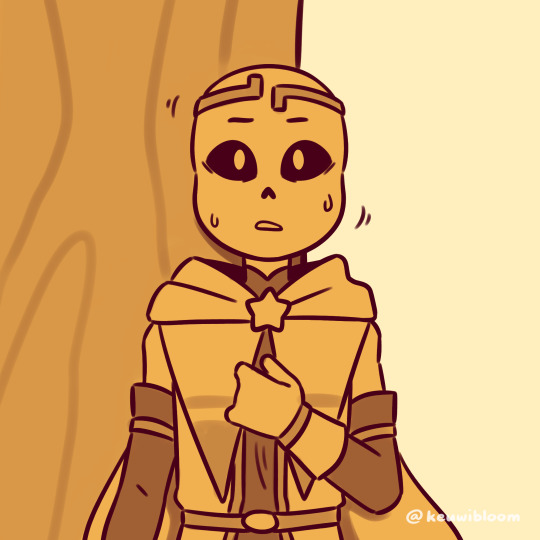
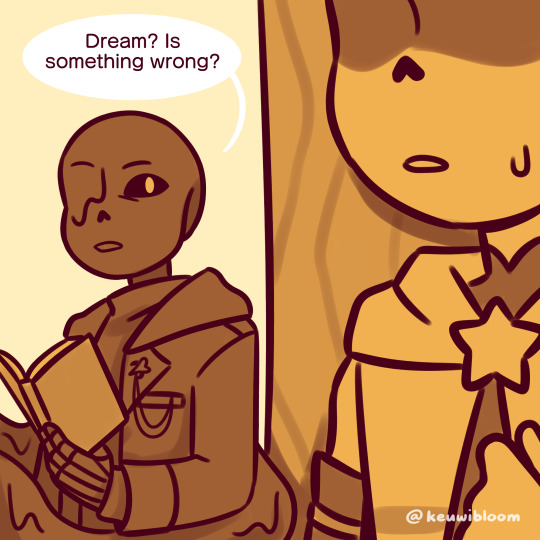

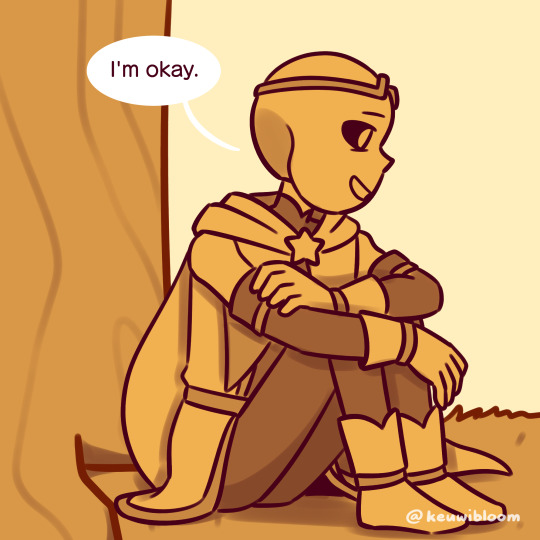

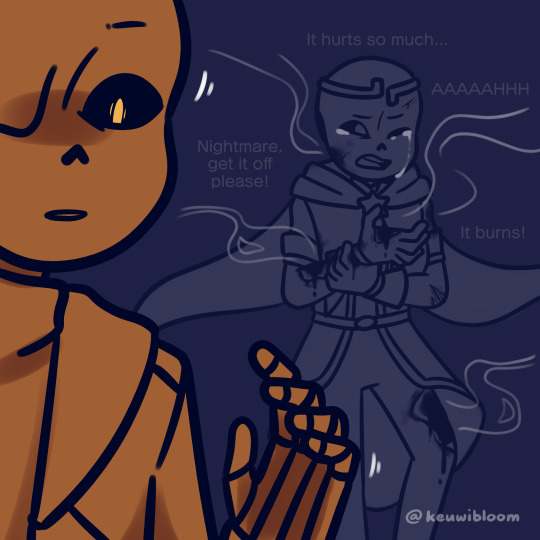
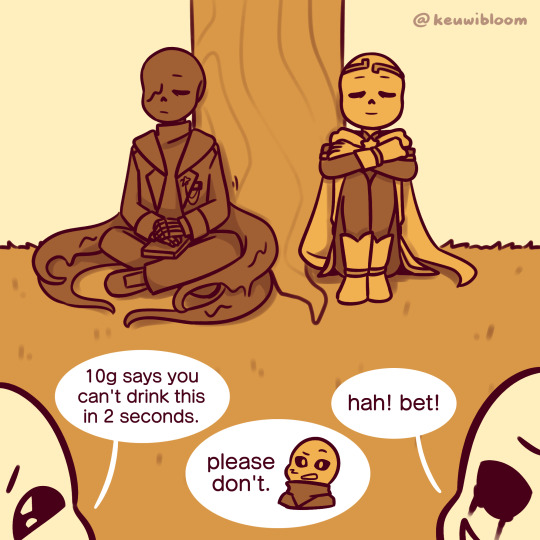
With how their whole positivity/negativity thing works (and that they're the only ones who can mortally wound each other), what if Dream and Nightmare aren't able to physically touch anymore?
Imagine, in the past, the brothers' main love language was physical touch (hugs, play fighting, etc). But after they ate the apples, the negativity and positivity act like poison to the other as a defense mechanism.
Any prolonged contact will burn Dream and make Nightmare's corruption boil and melt. It is extremely painful for both of them.
Imagine how this affects them in Parallel Synthesis.
When after all the fighting, after they've settled on a truce, after they've found peace and are able to actually be brothers again,
there will always be that one thing they can never have back.
Btw this takes place during the lunch meeting mentioned here! The stars and the gang decided to have an outdoors lunch :]
Dream and Nightmare belong to Jokublog
#undertale multiverse#utmv#dream sans#nightmare sans#dreamtale#dream!sans#nightmare!sans#undertale au#undertale alternate universe#undertale#fanart#myart#parallel synthesis#keuwi talks#im back!! after a short break#this headcanon came to me and it would not leave#featuring ink killer and cross in one panel lmao#tw injury#cw injury#injury
2K notes
·
View notes
Text
Euphoria

line weight/vague lighting test :)
#isat#isat siffrin#in stars and time#isat spoilers#<- by virtue of no hat#ns.tiff#song: laur - euphoria (happy hardcore)#a parallel to synthesis dimension :) i like when songs make me think of things 2 draw
209 notes
·
View notes
Text
About me (Zahra | زهراء):
Nickname is Zahura;
Loves fashion + foreign languages;
Lebanese;
Best subject in school was math;
Loves Pinterest;
Lucky number is 7.

All of my important tags that I use to organize this page are in the tags below.

#i was actually in papillonlisse in beauxbatons#hogwarts legacy#relatable#omg#healing#growth#lol#pretty#reference#Skyrim#plagiarized information synthesis system (piss)#Barbie#Star Wars#Pokémon#dungeon meshi#scooby doo#space orcs#rdr#political#free Palestine#falastine ask#detective comics#Jason Todd loves his wife#personal#deny defend depose#parallel eerieality#hxh#love#monster high#animal crossing
4 notes
·
View notes
Text

5 notes
·
View notes
Text
2025 is Meliora’s 10th anniversary and I’m not going to be quiet about it.
Recently, I’ve been focusing a lot (…again 😅) on the cultural movements that inspired the entire Meliora era, especially Futurism.
Knowing from Bishop Necropolitus Cracoviensis II that Terzo studied the Futurist manifestos during his formative years in Krakow (most likely Marinetti’s), I like to believe that the main inspiration for Meliora’s aesthetic came from the architectural drawings of Antonio Sant’Elia. The parallels between Filippo Tommaso Marinetti and Antonio Sant’Elia with Terzo and Necropolitus are quite evident:
(...) We would sit down to studying exciting Futurist manifestos, sketched the blueprints of utopian metropoles, spiked with shiny skyscrapers stabbing at the heavens belly... Wantonly swollen zeppelins would to carry our gospel of indulgence to the farthest corners of the globe to summon and enslave.
BP Necropolitus
We had stayed up all night, my friends and I, under hanging mosque lamps with domes of filigreed brass, domes starred like our spirits, shining like them with the prisoned radiance of electric hearts. (…) Alone with stokers feeding the hellish fires of great ships, alone with the black spectres who grope in the red-hot bellies of locomotives launched on their crazy courses, alone with drunkards reeling like wounded birds along the city walls.
F.T. Marinetti - Manifesto of Futurism
Easy to imagine Terzo and Necropolitus—half stoned, half dazed, and inexorably intoxicated by a party that had been going on for hours—retracing, for the hundredth time, the highlights of the Futurist Manifestos they had read over and over, fervently discussing the future and the modernity they dreamed of bringing with his papacy.
Sant’Elia was a contemporary of Marinetti, fathers of the Futurist movement, and his Manifesto for Futurist architecture shares much of Terzo’s vision for Meliora, the city he created.
Each generation will have to build its own cities. Sant’Elia said.
that, just as the ancients drew their inspiration from natural elements, we – materially and spiritually artificial – must find our inspiration in the new mechanical world we have created, and our architecture must be its most beautiful expression, its most complete synthesis, its most effective integration; (…) by architecture, I mean the effort to freely and audaciously harmonise man with his environment, that is, to make the material world a direct projection of the spiritual world;
A. Sant’Elia - Manifesto of Futurist architecture
(...) Forged in nostalgia of steam and fire, this brave new world of ambition, vice, lust and greed - all so inherent to the enlightened modernity, was always with him through all these years.
BP Necropolitus
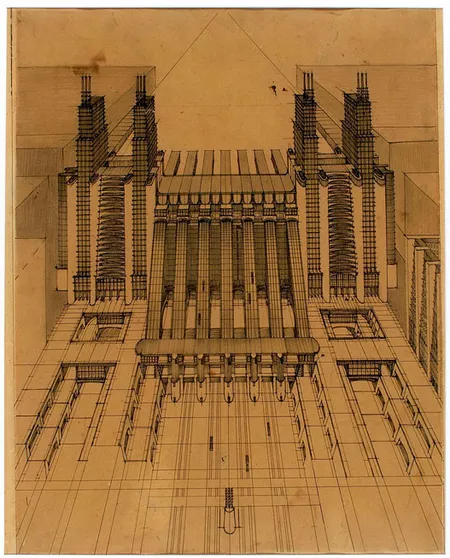
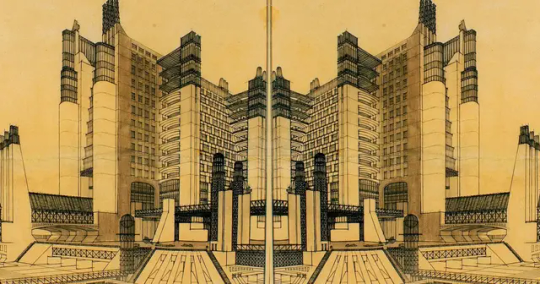


The Futurist movement embraced all forms of art, from painting and sculpture to architecture, music, and literature. It was characterized by a burning hatred for the past, which they wished to destroy, and a glorification of machinery, new technologies (we’re talking about first 20 years of 900), dynamism, speed, modernity, and rebellion. Nothing was meant to stay still, everything had to move, transform, evolve… very much in line with what Terzo seemed to believe.
But there was a downside. The original Italian Futurism became closely tied to fascism. It also celebrated violence and war, seen as tools to “clean up” and make space for the new. Most of the founding artists died in a war (World War I) that they had glorified and willingly taken part in. And when the dictator fell, so did the Futurist movement.
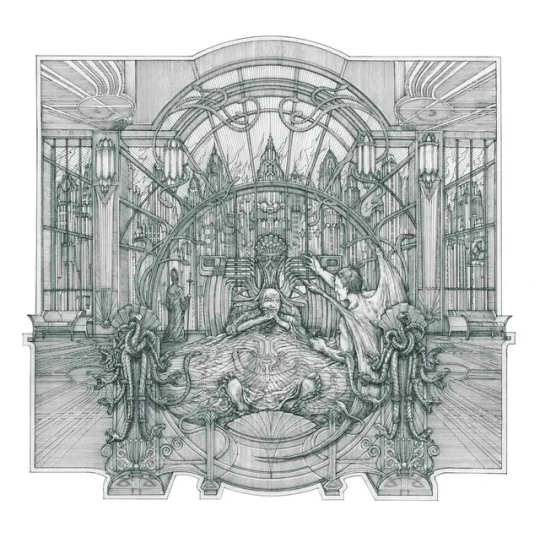
The lives of these artists were brief, but they remained true to their ideals, for better or worse, from beginning to end.
Erect on the summit of the world, once again we hurl defiance to the stars!
F.T. Marinetti - Manifesto of Futurism

At this point, I’d like to explore the association between the shapes in Futurist painting and the shapes of Terzo’s face paint, slipping swiftly into Cubism and Piet Mondrian’s simplification of form as a parallel to Terzo’s geometric, minimalist design… but that’s a story for another time.
#the band ghost#papa emeritus iii#terzo emeritus#bishop necropolitus cracoviensis ii#meliora#I love his era your honor I’ll never going to shut up about him#Happy anniversary Meliora
75 notes
·
View notes
Text
so we see in birth of the demon that ra’s initially discovered the pits in his quest to find something to aid the emperor’s son. his first attempts to cheat death were borne of two desires: the first being to help people, the second being his own pride.
though ra’s develops an enduring hatred of humanity later on, this glimpse into his youth shows us that he was a man of science, one who valued and appreciated the beauty of life. and there is a parallel to thomas wayne here as well; both went to great pains to help the sick, and were depicted as valuing life and the values of their vocation, even when their patients had wronged them (gotham’s criminals, and the emperor’s son). and they are both betrayed for it. ra’s has to see his wife be assaulted and murdered by the man he helped save, and is almost killed at his hands as well; all of thomas’s aid to gotham’s unfortunate is repaid with his and martha’s deaths.
thomas could not carry out his retribution, if indeed he wanted to. ra’s went on to become the demon’s head, a supervillain made distinct from the rest of batman’s roster of enemies due to his principled nature. but knowing and growing up with this grief is not enough to dissuade their children; it is his parents’ deaths that result in the creation of batman. and talia, raised in the shadow of her father, still chooses to study medicine, to leave her father’s league and everything she’s ever known, to help the people her father vows to kill.
there is a tendency in a lot of damian’s stories to contrast the two sides of his family, and the twin legacies he’s given. often, he’s asked to choose between them, as if being an al ghul is somehow mutually exclusive with being the son of bruce wayne. but his recent foray into medicine in the newest issue of batman & robin (#16) is a great bit of character development, and a synthesis of his families’ values. through medicine, he can carry the legacies of both his grandfathers, and embody the beliefs that united his parents. and unlike all the other inheritances he was made to bear, he chose this one all on his own.
78 notes
·
View notes
Text




“All perceptible matter comes from a primary substance, or tenuity beyond conception, filling all space, the akasha or luminiferous ether, which is acted upon by the life giving Prana or creative force, calling into existence, in never-ending cycles all things and phenomena.” ― Nikola Tesla
Quetzalcóatl - Force of Nature Talon Abraxas The Fifth Pachakuti and the Rise of Quetzalcoatl The Era of Potential Unity
The Fifth Pachakuti, which began in the 1990s according to the Pachamama Alliance’s interpretations, marks a prophesied era of potential reconciliation and unity between the disparate paths of the Eagle and the Condor. This era is viewed as a pivotal moment in human history, where the aggressive, industrious, and mind-oriented energies of the Eagle could harmoniously integrate with the intuitive, nature-connected, and heart-oriented energies of the Condor. The prophecy suggests that these two forces could metaphorically “mate,” merging their distinct virtues to give rise to a new, elevated form of consciousness that transcends their individual limitations.
This new epoch is characterised by a global awakening to the interconnectedness of all life and a renewed appreciation for the principles of balance, respect, and reciprocity with nature. It is a time when humanity at large is called upon to blend the scientific advancements and technological innovations of the Eagle with the ecological wisdom and spiritual insights of the Condor. This synthesis promises the advent of a more sustainable, just, and peaceful world, embodying a higher state of collective consciousness and a renewed societal paradigm. Symbolism of Quetzalcoatl
Quetzalcoatl, often depicted as a feathered serpent, embodies the culmination of this metaphoric union. In Mesoamerican cultures, Quetzalcoatl is not only a deity of significant religious importance but also a symbol of the integration of the heavens (bird) and the earth (serpent), mirroring the desired amalgamation of the Eagle and the Condor. This powerful imagery captures the essence of balance between opposing forces: the sky and the ground, spirit and matter, intellect and emotion.
Drawing a parallel with the Mayan quetzal bird, known for its strikingly vibrant plumage and revered in Mayan culture as a symbol of freedom and wealth, Quetzalcoatl enhances this symbolism. The quetzal bird’s ability to thrive in the air yet remain connected to the earth encapsulates the ideal of living in harmony with both the material and spiritual dimensions of existence. Quetzalcoatl’s representation as both bird and serpent effectively symbolises the integration of heart and mind, art and science, and masculine and feminine energies.
In the context of the Fifth Pachakuti, Quetzalcoatl represents the potential for humanity to reach a state of enlightenment where scientific and technological prowess is used wisely to enhance life and honour our deep, innate connection to the Earth and each other. This new consciousness is characterised by a holistic worldview where art and science, mind and heart, male and female are no longer seen as dichotomies but as complementary forces that enrich human experience and help solve the world’s most pressing challenges through creativity and collaboration.
Thus, the rise of Quetzalcoatl in this current era symbolises hope and the potential for a profound transformation within human society, pointing towards a future where balance and harmony prevail over division and conflict. This emerging consciousness invites all of humanity to participate in a grand synthesis, which promises to reshape our world with wisdom, compassion, and equilibrium.
36 notes
·
View notes
Text

The return of my Ink variant AKA Opal from Parallel Synthesis!
He got a bit of an outfit update since the last time I posted anything related to my AU, and honestly there's a lot of small adjustments and additions I wanna do. Here's hoping I can get to them!
Ink belongs to Comyet
Parallel Synthesis AU belongs to me
#undertale multiverse#utmv#ink sans#ink!sans#parallel synthesis#parasynth#parasynth opal#undertale au#fanart#myart#hes a lot more colorful now :D#im hoping to do an updated character sheet for everyone soon!
129 notes
·
View notes
Photo

Britomartis
Britomartis, also known as Diktynna (Dictynna), was the Cretan goddess of hunting and fishing nets in Greek mythology. Although referred to as a nymph and worshipped locally, she had at least two significant and active shrines, one in Crete and another in Aigina, where worshippers would bring offerings. They regarded her as a vanished maiden immortalized and deified by Artemis.
According to her most popular myth, Britomartis, meaning "sweet maiden," was an exceptional huntress and a beloved companion of Artemis. As such, she had vowed to remain a virgin. Nevertheless, King Minos desired her and relentlessly pursued her for nine months. He eventually caught her atop a high peak and attempted to seize her, but Britomartis leaped from the cliff into the sea to escape. She was recovered by fishermen's nets (diktuon) and brought to the island of Aigina. There, Artemis transformed her into the goddess of the nets, Diktynna, to preside over her own cult.
Despite her clear Cretan origins, Britomartis/Diktynna was likely a minor goddess who was reintroduced into the Bronze Age pantheon of the island by Classical Greek writers. Over time, Diktynna came to be associated with divine genealogies and was even included among the children of Leda by Zeus, Apollo and Artemis. Her cult remained popular throughout the Hellenistic and Roman Imperial periods, as evidenced by the archaeological remains of her sanctuaries and the coins bearing her image.
In Minoan Religion
The Cretan system of sacred beliefs and practices is marked by impressive processions, bountiful sacrifices and offerings, mystery symbols such as the double-axe (labrys), and ritual activities such as bull-leaping. It also features painted and sculpted images of female characters commonly interpreted as goddesses or priestesses, most typically with raised arms. Some of these goddesses/priestesses are shown holding snakes, which led Sir Arthur Evans (1851-1941), the key figure in the discovery of the Minoan civilization, to suggest they may represent a 'Great Mother Goddess' and her fellow associates.
The discovery of numerous inscriptions at Knossos, an archaeological site he believed to be King Minos' palace, convinced Evans that deciphering these inscriptions would reveal a clear understanding of his material finds and their significance in the Minoan religion and culture. He dedicated his life to this effort, only to find that the inscriptions represented three different scripts: Cretan Hieroglyphs, Linear A, and Linear B. While the first two scripts remain undecoded, the Linear B script was eventually deciphered by Michael Ventris (1922-1956). As nearly all the tablets read since then contain administrative and commercial records, understanding the Minoan religion has largely remained dependent on drawing parallels between pieces of visual evidence from art, archaeology, and architecture. In other words, we have no written evidence yet that can directly tell us what the Minoans used to call their goddess or goddesses.
Minoan Snake Goddess, Knossos.
Mark Cartwright (CC BY-NC-SA)
Still, there is a foundational agreement among the scholars that the Minoan religion, like many other aspects of this culture, was later adopted or adapted by the Mycenaeans and Greeks. Just as Michael Ventris demonstrated that the language of Linear B inscriptions is an early form of Classical Greek, scholars such as Jennifer Larson explain that
From its beginnings in the Bronze Age, “Greek” religion was a synthesis. The strong influence of Minoan ideas and aesthetics is clearly discernible in the material culture of Mycenaean religion…
(138)
The idea of the persisting prominence of several gods and goddesses such as Zeus, Apollo, Dionysus, and Athena from the Minoan down to the Mycenaean and Greco-Roman cultures finds material support in the names of these deities on a few Linear B tablets. These tablets were discovered at the Palace of Nestor in the Mycenaean city of Pylos, c. 1200 BCE. The tablets list the offerings and sacrifices that were dedicated, or must be dedicated, to each deity. On one tablet, Tn 316, the divine recipients of gold vessels include Zeus, Hermes, Hera, and Potnia. The name Potnia, written as po-ti-ni-ja in Linear B, means "The Female God Who Has Power." This title was given to several important goddesses in Minoan Crete, sometimes as an epithet, e.g. Potnia Athena, sometimes denoting the geographical or functional attribute of the goddess, e.g. Potnia Hippia (Mistress of the Horses), and sometimes solely as her name or title. If we trust that Potnia must be the Minoan/Mycenaean designation for sacred female figures in the Minoan art because they are both noticeably frequent, then it is likely that this Minoan/Mycenaean great goddess survived the Bronze Age Collapse and made her way into the Archaic Greek pantheon in the form of one or more female deities.
Since the Bronze Age goddess was often featured concerning warfare and protection, most scholars suggest that Athena is the Greek revival of Potnia. Nevertheless, the Cretan goddess, who was consistently honoured and praised by Greek writers from the 5th century BCE onwards, was Britomartis/Diktynna. And she was explicitly linked to Artemis and, later, to her divine family.
Minoan Gold Signet Ring with Three Figures before a Temple
Nathalie Choubineh (CC BY-NC-SA)
Continue reading...
38 notes
·
View notes
Note
🔥 have any thoughts on the “enemies to lovers” trope and its use or perception in storytelling?
it is my fav for ships sorry idc im a basic bitch i truly dont care like its sexy to me im sure i can pull some pretentious nonsense as to what this type of dynamic gives me even at a subconscious level out of my ass but like. idk what would qualify as a hot take. ig as much badly written garbage is attached to it (as with every other trope) ppl who try to be fringe and condescending about it make me roll my eyes lol. especially if its ridden with “oh those silly women and their cliche and overrated enemies to lovers dark romance 🙄” or lame psychoanalysis lmao. ofc ppl r very drawn to a dynamic that has conflict embedded into it like this bc it tends to be interesting for a story. two characters with drastically opposing ways of viewing and interacting with the world in a fundamental way will result in some kind of meaningful parallax and lead to a relationship with a lot of dynamism. it is a good vehicle for dealing with two characters as foils and parallels too and lead to a potentially interesting synthesis. theres also that feeling of them knowing each other very holistically or whatever. like ofc its popular all this makes for v fun interactions and dynamic on the surface
i also wont be trite here with “u guys only want defanged enemies to lovers that doesnt even qualify as that” bc ofc my preference tends to lean towards when its more brutal and #edgy or whatever but to be frank with u everything has been said and i only give a shit when ppl cry about shit being #problematic and idc if u like the version of it where its just office rivals hating and bickering w each other lol like sure i can see how it echoes the feelings i described above. i dont particularly care about treating these tropes as very strict labels and monoliths like we r at a point where i dont think we can restrict the definition of this by virtue of how it is in popular culture now and how the label functions in practice
33 notes
·
View notes
Text


As an overarching principle order played an important role in Le Corbusier’s oeuvre: in the sense of Ancient Greece it represented a sign of creation and its maintenance a sign of morality. Against this background the current exhibition „Le Corbusier - The Order of Things“ at Centrum Paul Klee elaborates on the meaning of order for Le Corbusier and offers comprehensive overview of his entire output from an artistic perspective. Alongside the exhibition Scheidegger & Spiess published the eponymous and exceptionally beautiful catalogue that collects Corbu’s drawings, paintings, books, texts, built and unbuilt projects. In addition, experts like Tim Benton and Arthur Rüegg as well as curator Martin Waldmeier in their essays address numerous aspects related to Le Corbusier’s research, painting and drawing processes that precede and supplement his architectural designs.
What is immediately striking is the sheer diversity of Le Corbusier’s creative process and the very fact that our image of him is fragmentary: his „recherche patiente“ was aimed at a synthesis of the arts that covered all of the aforementioned aspects and resulted in extensive and diverse bodies of work that are rarely considered side by side.
He regarded his research as a key to his work and the exhibition as well as the catalogue document that this indeed was true: Corbusier’s central concern was the aesthetic experience that added to or even overruled his preference for the rational, pragmatic and analytic. Throughout his career he carried out his artistic work in parallel to his architectural work as an impulsive, sensual research that threw a bridge to architecture.
With „Le Corbusier - The Order of Things“, which runs through June 22, the Centrum Paul Klee on the occasion of its 20th birthday offers the rare opportunity to discover Le Corbusier’s complex and fascinating artistic work. While his architecture cannot be considered without his „recherche patiente“ it is often only regarded as a footnote to his architecture, a notion that the exhibition and the accompanying catalogue revise and rebut. A highly recommended read that offers a multitude of cues for further research!
27 notes
·
View notes
Note
Sorry if you've answered this before, but what's your opinion on post-canon Doug? As in, after he's lost all his memories? Do you like to imagine that he regained all of his memories after some time, or that the crew maybe just helped him settle back in? Do you imagine his personality changing dramatically, or staying mostly the same?
hi, first of all, i'm so sorry this took me months to reply to. by now, maybe you've seen some of my other posts about eiffel's memory (there are a lot of them!) and this might be mostly me repeating myself, but i don't mind re-answering questions, and this one in particular is something i come back to a lot. for obvious reasons.
i think eiffel will regain his memories; in my mind, he's only without them for maybe... at most, six months? to me, it makes the most narrative + thematic sense to treat it like lovelace's death: it's a catalyst for character growth, it sort of forces a synthesis of those themes of identity + autonomy + accountability. eiffel is a man who has spent his entire life trying not to face the person he's been, trying to narrativize and step outside of himself to avoid the guilt and the responsibility of his past mistakes. the show repeatedly holds him to account for this behavior. even within the structure of the finale: he's confronted with his memories, trapped inside of himself, and then confronted with his logs, trapped outside of himself. ... then what?
there are a few plausible options for the "how" of it: lovelace's blood is still in his system, it broke him free from pryce's mind control - on a delay, even - memory is clearly something the dear listeners can replicate, there's nothing to say it would treat something like memory loss any differently than something like decima or lost fingernails. alternately: pryce scanned eiffel's memories back in episode 55, and that scan could easily have been backed up somewhere at canaveral. however it plays out, i think there's something compelling about the idea of it being eiffel's choice to regain his memories and to be doug eiffel again, for how that parallels lovelace, for how it mirrors hera choosing not to give up her memories in memoria, and for how it sort of... expands the way late-series wolf 359 "equalizes" the treatment of other characters' minds, especially eiffel's, to emphasize that hera is not as different - and not as doomed - as she's been led to believe.
(i've said before that i'd want eiffel to regain his memories through an "eiffel version of change of mind", which i've elaborated on here. short version: i think he has to confront all these different versions of who doug eiffel is, good and bad, and accept that they're all doug eiffel, in order to move forward, and to set things right as much as he can.)
i think it's notable that eiffel first asks, "am i still that same person [in the logs]?" and then, at the end, "am i still doug eiffel?" because those are different questions with different answers. the eiffel he was right before losing his memory was not that same person. minkowski is also not the person she was during succulent rat-killing tar, that's just kind of... how it is to be a person. but is he still doug eiffel? well...
this post is already long, so here's another one about memory in wolf 359, but. summarized. it'd be easy to take away from memoria that "you" are your memories, but i think that's incomplete. if memory is the part where "you" come in, if "everything before memory is about the world around you. everything after it is all in your head. it’s where you go from objective reality to subjective reality." then there is some other part to it, some other "you" that filters and prioritizes and processes that external information. eiffel's memory wipe is obviously not a complete one: if he lost his memories, but still retains the ability to speak, to understand the context and consequences of his past, even basic motor control, etc. then it's not really a "factory reset." he's missing some important context for why he is the way he is (and, i imagine, why he knows the things he does - i like to think he just instinctively knew how to operate the comms equipment without anyone instructing him on it, even if he can't remember learning how to use it) (and since he primarily communicates in pop culture references, it makes sense to me that he comes across a little more subdued; confusion and everything else aside, he doesn't have access to a pretty key part of his primary mode of communication) and he's already grown as a person, and he will keep changing, but he will keep being doug eiffel. however he might feel about that.
#wolf 359#doug eiffel#asks#ultimately i think it's like. if you assume eiffel is still eiffel then it all loops back around on the established themes of the show#and the way other characters assert their identities by name in the finale in particular#but if you assume he isn't. if he's a different person without his memories. if he never gets his memories back etc.#then those are brand new questions about identity. and it doesn't work as a conclusion with the tone of the show. if that makes sense#or at least that's how i feel about it.
19 notes
·
View notes
Text
Pitchposting: The Waves
Here's the logline: a hero flits between universes where everything is different and yet all characters recur. The love interest is the same, whether she's a pirate captain, a cubicle worker, a bard, whatever. The villain is the same, whether he's a rear admiral, a corporate tyrant, or an evil overlord.
Multiverse stories are often about the path not traveled, the way that the world might be different. This would be a story about commonality, everything staying the same.
So there are some number of stories being told here, and the shape of all of them is exactly identical, all hitting the beats at the same time. A death in one means a death in the other, but our protagonist is only in one place at a time, so we see each beat only once and infer the rest. A car chase in one story is a ship chase in another. The climactic battle where soldiers crash against the castle walls becomes a climactic battle where the pirate horde smashes against the walls of a fort, and that turns into a modern cityscape where rioters smash against the walls of a towering skyscraper.
My vision here is that we do grand changes as we move between stories, only to find that everything is equivalent.
So what do you do with this? What's this sort of structure for? What cool stories or scenes does it lend itself to?
My first thought is to break it, naturally. If there are five or six realities that we're cycling through, maybe our protagonist can get just one of them onto a different track, one where fate has something else in store. I don't know how you would do this, there's this neat scene in my head where we go "all is lost -> all is lost -> all is lost -> all is ... wait, what's that?!".
My second thought is that having multiple realities moving in perfect synchronicity with each other allows for a way to really underscore a character, say something about them with thick red marker. The elemental thing that's supposed to define a tragedy is that the bad ending is something that came from within the character, right? Something that they could have stopped, if only they had been a different kind of person. The seeds of their downfall laying within them. So isn't there something nice about seeing that this is invariant? That the worlds are different, circumstances are different, but the choices are the same? You'd have to be incredibly careful with this (and the whole thing, really), because I think in constructing different parallels you might end up with something that the audience doesn't consider parallel. But it could work, layering the emotional beats on top of each other.
My third thought is what I think should have been my first thought: the story is one about mastery, coming to know and understand the rules, "winning" across all realities because of understanding, ideally with some kind of character synthesis along the way. I think this is ... well, difficult, given the rules as I've been talking about them. If there's a "twist", then it should be a twist that happens across all realities simultaneously. If there's something gained or lost, it should always have a parallel. I cannot immediately think of some clever way of breaking this system - something that the reader would understand to be clever or at least worthwhile. (I say reader, but this would be better in a visual medium.) Maybe "breaking it" in a different way is the ideal, pulling the realities into each other, swapping conceits and genres. But this, too, would take a lot of planning to pull off, and you'd need to be careful about these set pieces.
So if I were serious about this (which I'm not, this is pitchposting,) I would start out with our characters, then build some worlds around them, trying for maximum variation in those worlds. The plotting is also pretty vital, particularly the "standard" plot whether you're going to break that or not. I do really like the idea of having a single "mundane" world, a place of office buildings and stakes that are measured in lunch breaks and water cooler conversations. I want the swings to be extreme, but the parallels blindingly obvious when they're put in front of you.
To be clear, I'm not sure that this structure/gimmick could actually work. In a text medium, which is what I primarily work with, I think you'd have to spend too much time on blocking and descriptions and detail whenever you switched realities. Switching scenes can be rough even in the best of circumstances.
But it's an idea that I've had rolling around in my head, and if I can't do something with it, then I hope it can at least spark something in someone else.
44 notes
·
View notes
Text
genuinely very kind loving people who have no qualms about lying cheating breaking the law etc
dangerously reckless
almost uncomfortably friendly like in a “what’s wrong with this child” kind of way
still love and idolize their fucked up deadbeat dads, not out of naivety, but with a surprisingly full understanding of what they did
have a complicated but loving relationship with their adopted parent in which lies are an important theme of their interactions
described as being someone else’s “light”
bizarrely competent for their age
crushed by repressed guilt over something they perceive as a failure and feel complicit in, despite having very little control over due to being children
do extremely morally grey things because of that guilt
adorable
this thought popped into my head about .2 seconds ago so i’d need to think about it some more but low key trucy wright and gon freecss have so much in common
#hxh#obv this is a little surface level bc they are still foundationally very different people but like.#the parallels are just There enough to have me going like..... hmmmm. they should be friends#aa#frogs.txt#stupid synthesis
7 notes
·
View notes
Text
I understand that the movies are meant to be external to the flow of the main narrative, but the development of Izuku and Rody’s friendship could so easily have been used as a guide for the ‘save the Villains’ narrative to resolve more effectively. To demonstrate what I mean, here’s a breakdown of their relationship arc as well as I can remember it:
I - First Impressions
Izuku initially attempted to arrest Rody for assisting a jewel heist, only to be called out for acting outside the law (bc they’re in a country where Izuku does not have jurisdiction as a hero).
He nevertheless demands to search Rody’s briefcase which is, again, illegal regardless of whether Rody actually stole anything (he did, though the briefcases being swapped makes it look like Izuku was mistaken). Izuku is acting as a vigilante here while still expecting his position as a hero student to cover his ass.
Despite this, when Otheon police arrive with a show of grossly excessive force and no regard for due process, Izuku’s priority immediately becomes saving Rody. The legal authorities are in the wrong, the system cannot be trusted, so Izuku very publicly opposes them.
Naturally, this decision places Izuku firmly outside the protection of the law, and he is punished by being framed for the murder of 12 civilians by a government under the extensive influence of a quirkist - in this case, anti-Quirk - cult, Humarise (which could be seen as a parallel to the HPSC’s corruption/shadowy assassin operations).
II - Thesis & Antithesis
Later, while on the run, Izuku and Rody engage in a dialogue in which Rody critiques Izuku’s black-and-white moral dichotomy: Izuku claims that they can’t return the briefcase of encrypted evil-scheme documents to Humarise because they’re Villains, and Rody snaps back that not everyone has the luxury to be so righteous.
(Rody’s backstory has pretty obvious parallels to Twice’s: being denied honest work and alienated from society for reasons outside his control, leaving crime the only viable way to make a living. He also parallels Hawks in that this alienation is a consequence of his father’s crimes, in addition to the ‘Otheon gov’t under Humarise = HPSC’ idea.)
Izuku does not stubbornly argue Rody’s point but instead switches to the more pragmatic argument that a big, shady organization like Humarise wouldn’t just let them walk away after handing over the papers; they would most likely kill them both to tie up loose ends. (He is proven right about this shortly after.)
III - Synthesis
And here we come to a turning point: Rody ignores Izuku’s instructions and sneaks out at night to deliver the briefcase to a Humarise agent who, as predicted, tries to kill him after obtaining it. But despite having been ‘betrayed,’ Izuku once again rushes to protect Rody from the threat he created (or rather, made immediate).
When Rody demands to know why Izuku would save him after what he did, Izuku responds simply that he’s trying to be a hero who saves people, and he doesn’t see why that should exclude someone like Rody. (Izuku references this worldview in the main storyline wrt Aoyama and Lady Nagant: “Doing something wrong doesn’t mean you’re a Villain forever.”)
This reintroduces their discussion of who has the privilege to behave heroically. Rody, like multiple other characters , assumes that Izuku has had an easy life thanks to his flashy, powerful, heroic Quirk. But unlike with, for example, Shinso or Monoma, Izuku directly refutes this and (without revealing OfA and his former quirklessness) talks about his own hard journey.
(Which is crazy because Izuku is not someone who does this. He is committed to becoming a Symbol like All Might and saving people with a smile, not letting them see his internal struggles. He doesn’t even take the hero mask off in front of his friends in 1-A: as early as the Sports Festival arc, he tells Shoto that he’s always had the support of others when this is transparently untrue.)
IV - Conclusion
In the end, Rody chooses to help the heroes stop Humarise and then, with his family history no longer hanging over his head in the same way, returns to legal work (bartending) with plans to pursue his dream job (piloting). This isn’t because Izuku managed to change his fundamental values/ethics: his priority is and has always been providing for his family and keeping them safe.
Izuku’s influence consists in the belief that there may be other ways to accomplish those things. And while Rody does have to take a leap of faith (not caving to the Humarise leader’s threats against his siblings because he trusts that he and Izuku working together can stop the cult before those threats are realized), his decision to ‘go legit’ is the result of material changes in his circumstances. He can now afford to act within the confines of the law.
25 notes
·
View notes
Note
Do you have any fav ships (from any fandom) that the dynamics remind you of XueXiao? Why?
So, anon, you've opened the Xuexiao/Hualian parallels floodgates... I strongly believe that Hualian are Xuexiao reincarnated for a second chance at happiness!
Here's why:
The overall vibes are there! The kindhearted, somewhat naive, and very powerful one trying to help people in a world with difficult and complicated problems x the morally dubious but surprisingly loyal one who does the necessary dirty work and makes the other smile.
The last act Xue Yang does to initiate their final confrontation is breaking Xiao Xingchen's door, first act Hua Cheng does for Xie Lian in the main canon timeline of TGCF is make a door for him.
Xue Yang attempted to revive Xiao Xingchen for 8 years, Hua Cheng waited 800 years for Xie Lian.
Xiao Xingchen descended his mountain at age 17 to help the common people. Xie Lian ascended to the heavens at age 17 to help the common people.
Hua Cheng is especially paranoid about Xie Lian touching corpse powder and committing suicide. Enough said.
Xue Yang tells Xiao Xingchen to never forget him when they part for the first time after Xue Yang's arrest. Xie Lian tells Hua Cheng to forget him when they part for the first time after Xianle's downfall and Hua Cheng insists that he won't.
There's a whole extra in the last book which is just giving Hua Cheng a reason to call Xie Lian "daozhang" and pretend to not know him.
Hua Cheng's sacrificed eye, Xiao Xingchen's sacrificed eyes, and Xue Yang's missing pinky... there's some synthesis of these in my head that I can't quite put into words but hopefully you see the vision (or lack of vision lol).
Hua Cheng's whole thing was that he had a very unfortunate childhood and would've died or become extremely fucked up like Xue Yang had been, but Xie Lian breaks the rules to save him, changing fate. If Xiao Xingchen had been there for Xue Yang as a child, things might've turned out differently.
Their whole relationship metaphor and what makes them work well together in fights is Hua Cheng transferring spiritual energy to Xie Lian regularly, just like what Xue Yang did to Xiao Xingchen.
Hualian can dual wield each other's spiritual weapons in a way that no other characters can, like Xuexiao.
Jun Wu tries to make Xie Lian evil and fails, and Xie Lian chooses to die over continuing down the route of evil as soon as he realizes what is going on, just like Xiao Xingchen did.
Xie Lian admits to revenge crimes he didn't do and Hua Cheng feels a need to right this injustice, a foil to Xue Yang dressing up as Xiao Xingchen to commit revenge crimes on his behalf, framing him.
Xie Lian was the only one who saw Hua Cheng's talent even when he was a complete nobody delinquent from an unimportant family, like Xiao Xingchen was implied to have done in the MDZS villainous friends extra.
Hua Cheng promises to come back after "dying" and Xie Lian just believes and trusts in him, as compared to Xiao Xingchen dying and Xue Yang trying desperately to bring him back, not believing that failure was an option.
There's more but this post is long enough as is...
37 notes
·
View notes